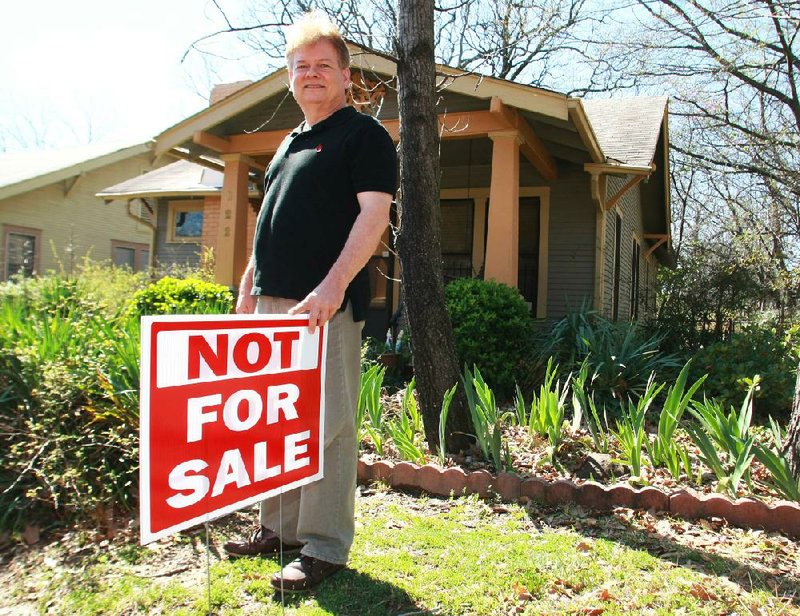LITTLE ROCK — There are dozens of plants lining the front and back yards of Rohn Muse’s house, some transplanted from his mother’s yard in the 25 years since he bought the little house in the Forest Hills neighborhood.
Boxes of marble tile are stacked neatly waiting for a green light that Muse’s house will not be one of those bought, or taken by eminent domain if necessary, to build the Little Rock Technology Park.
Neighbors in at least one of the three sites identified for study at the end of last year have started putting up signs in their yards reading “Not for Sale,” to let the technology park authority’s board of directors know they want to stay, said Muse, who paid for the signs to be made.About 40 signs have popped up between West 11th and West Eighth streets.
“Before this came about, none of us have ever advertised our home as being for sale because we are happy where we are and we want to stay,” Muse said. “There is one ‘For Sale’ sign in our area, that’s unusual for any neighborhood. You are looking at a well-kept neighborhood and some people have lived here going on 55 or 60 years.”
Members of the technology park’s board, which launched a new website Monday to make the research documents and board meeting minutes available to the public, said the concern from neighbors is understandable but premature. The park is a joint effort between the University of Arkansas at Little Rock, the University of Arkansas for Medical Sciences, the city of Little Rock and the Little Rock Regional Chamber of Commerce.
“The unknown is always threatening, but if they’re convinced of the location, then they’re ahead of us,” said board member Dickson Flake. “It’s difficult to provide reassurance at this stage because the first step in the reassurance is to narrow it down to one site and an alternate or just one site. That eliminates two-thirds of the anxiety, and from there, narrowing the chosen site will eliminate even more. Until we get there we’re trying to have an open discussion and answer whatever we can.”
The technology park authority was created by the Arkansas Legislature in 2010 to oversee the creation of the research park and with the intention of attracting startup companies interested in turning university research into practical applications. A study commissioned by the Legislature identified an area of the West 12th Street corridor as the most conducive spot because the authority was charged with finding a location within a five-minute drive of both UAMS and UALR and because of other factors the authority deemed necessary for success based on other successful research parks in the nation.
The study, called the Angle Study, also identified three potential sites, Flake said. Two of those sites are being studied by a civil engineer and the third was found to be too small to fit the parameters outlined by the Legislature, Flake said.
He said several members of the authority determined the parameters of the third possible site, where Muse lives, and it was added to the Request for Proposals to study. The site was determined before the board was formed in November 2011.
The sites under consideration are:
38.7 acres between Tyler and Jackson streets, bordered by West 18th Street on the south and by 13th Street on the north.
59.6 acres from South University Avenue east to Taylor Street, from Coleman Street north to West 19th Street, excluding the Pop A Top liquor store property at its northwest corner.
65 acres, where Muse lives, that run along the south side of Interstate 630, stretching from Monroe Street east to South Elm Street and south to West 11th Street.
“While I can appreciate the misunderstanding of folks who have not had a chance to look at that information, this is a process that has just begun as opposed to a process that’s already been completed,” said board member and Chamber of Commerce CEO Jay Chesshir. “That’s another reason why we wanted to get those documents up on a website to show the process that has just now begun, and start the conversation early.”
Flake said regardless of which site is chosen after the study is complete in three to six months, the authority will only end up taking about 35 acres to build the technology park. The authority is scheduled to meet with the Forest Hills Neighborhood Association on Thursday night and with the Fair Park Neighborhood Association on Saturday morning.
Muse and his neighbors, however, said they aren’t going to wait for the authority to determine a site before they start fighting to keep their houses.
“Eminent domain is an abuse in my opinion; it’s capitalism run amok,” Muse said Monday. “When the human factor is absent from the equation, it ceases to be equitable. We are discussing all of our options and looking at a host of strategies we’ll be discussing as the process moves forward. We want to stay.”
Once a site is chosen, the authority will start small by building the roads and a single office and laboratory building estimated to cost about $50 million. Part of the city’s sales-tax initiative approved in September will be used to fund about$22 million of construction.
The other partners in the project agreed to contribute $125,000 over a three-year period as seed money, but the remaining funding sources have not been identified.
For more information about the planned design, study areas or minutes from the board’s meetings, people can visit http://lrtechpark.com.
Arkansas, Pages 7 on 03/13/2012
